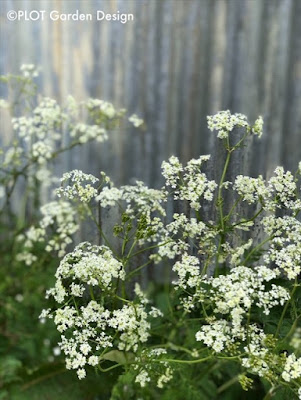A Seasonal Celebration of the Land, Garden & Nature

Beginning of Summer, Warmer Days, Burgeoning Growth,
Explosion of Green, Birdsong, Blossoming Potential, Darting Tadpoles.
Issue 15 May 2020
It's a wildflower
that's familiar to most of us - a tall elegant plant that moves around in the
May winds. Cow Parsley (Anthriscus sylvestris) has large, flat umbrellas of small, white flowers and large
fern-like leaves. If you crush the leaves between your fingers, they release a
strong aniseed scent.
There are several wild, white umbellifers that appear in May but cow parsley is the most
abundant and the first to flower. The
white flowers are called umbels (umbrella-like clusters of flowers) and cow
parsley is part of the Apiaceae family, more commonly known as umbellifers.
It's a big family comprising more than 3000 plants including carrots, parsley and
celery.
Clearly an ancient and well known wildflower based on the raft
of common names I found. Including Queen Anne's Lace, Wild Chervil, Wild Beaked Parsley, Kecksie, Grandpa's Pepper, Badman's Oatmeal and Rabbit Meat! In traditional medicines cow parsley was used as a digestive, for lowering blood pressure and to treat kidney problems. The plant is rumoured to be a natural mosquito repellant when applied to the skin and its leaves and flowers can be used to make a green dye. I also read that cow parsley can be used for baiting slugs but I can't shed any more light on that - can you?
Cow parsley is attractive to many wild creatures providing an early source of pollen. It's important for orange-tip butterflies, moth Agonopterix heracliana, hoverflies, bees and rabbits.
Top Tip: Cow parsley is often confused with the similar looking but poisonous hemlock. Confusingly many of the common names are used to refer to both plants. To distinguish Anthriscus sylvestris use these 3 identifiers:
The stems are hollow
Stem do not have spots
Leaves smell of aniseed
In the countryside cow parsley is a great companion to the wild roses, buttercups, bugloss, campions and dandelion clocks, flowering at the same time. If you want to grow something similar in your garden, consider Anthriscus sylvestris 'Ravenswing'. It's an elegant purple form of common cow parsley with the same pretty clusters of white flowers but with dark purple foliage. It's great for creating a wild naturalised look in the garden and is fantastic planted with ornamental grasses.
Alternatively (or perhaps additionally), Ammi majus has a similar look with lacey white flowerheads and finely cut green foliage. Ammi flowers slightly later than cow parsley and makes great cut flowers, lasting 10 days in a vase. You will have to stake Ammi as it grows - try using twiggy hazel or birch stems pushed into the ground. An added bonus is that finches love the ripened seed heads so if you leave them on the plants you might attract these lovely birds to your garden.
This year I'm growing Ammi majus from seed for the first time. They seem to have germinated fairly easily so fingers crossed for a great show and finches later in the summer!
For me cow parsley is not only lovely in May. In dark late December new cow parsley leaves start to appear. A hopeful sight and a reminder that although we're then experiencing the shortest days, the seasons are turning and the light will return.
However you decide to spend your days do try and get outside safely if you can - in your garden or on a balcony or taking your daily exercise outside away from others under big skies. Let me know what May highlights you spot and/or photograph
If you have any questions you can reach me via my website www.plotgardendesign.co.uk and please follow/like PLOT Garden Design on social media to receive my seasonal updates and photo
Keep well, breathe and remember to look outside and notice the details.





Comments
Post a Comment